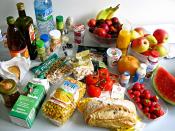�PAGE �
How Class Affects Food Choices
Social class can be defined by the structural, economic or cultural components that lead to the unequal divisions that exist within society. There have always been rich people and poor people in America and in a capitalist economy; food also marks a border between the haves and the have-nots. What people eat has become a marker of social status. As the distance between the rich and poor continues to grow, the freshest, most nutritious foods have become luxury goods that only some can afford. The wealthy will always eat well. It is the poor and working people in the United States who need a new, sustainable food system more than anyone else. They live in the most polluted urban neighborhoods, or they live in rural areas where there is a lack of infrastructure causing insufficient access to markets. They are exposed to the worst chemicals on the job.
They are generally sold the most highly processed, unhealthiest foods. And they can least afford the health problems that result.
Let's start with some statistics on obesity, as it is widely regarded as the most pressing nutritional problem in the U.S., and has been linked to cancer, heart disease, and diabetes. Obesity rates are highest in developed countries with the greatest income disparities. America is among the most obese of nations; Japan, with its relatively low-income inequality, is the thinnest (Pickett 671). African-Americans and Hispanic youth are more likely to be obese than non-Hispanic whites, and also more likely to be poor. In the 1970s, 5% of U.S. children ages 2 to 19 were obese, according to the CDC's current definition and by 2008, nearly 17 percent of children were obese, a percentage that held steady through 2010 (Ogden). Nationally, obesity adds an additional $190...


